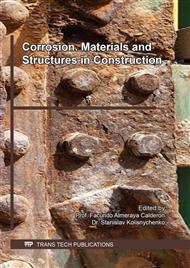p.218
p.227
p.233
p.239
p.245
p.251
p.259
p.265
p.271
Chemical Attacks in Geopolymeric Materials by Sulfuric Acid and Hydrochloric Acid
Abstract:
The geopolymeric materials present a viable alternative as concretes, the durability of these materials is associated to expected environmental conditions and one of the problems is their corrosion. The objective of this study was to assess the durability of geopolymeric materials through the chemical attack by sulfuric and hydrochloric acids with 5% concentration. After synthesis of the geopolymeric materials, followed by curing at room temperature for 28 days and then the geopolymeric materials were subjected to cycles of chemical attacks, which consisted of periods of seven days of immersion and seven days of drying at room temperature, four cycles were provided. The geopolymeric materials were characterized and it was found that they exhibit adequate resistance to chemical attack, the adequate strength consisted of determining the mass loss in each cycle attack.
Info:
Periodical:
Pages:
245-250
Citation:
Online since:
November 2016
Keywords:
Price:
Сopyright:
© 2017 Trans Tech Publications Ltd. All Rights Reserved
Share:
Citation:



